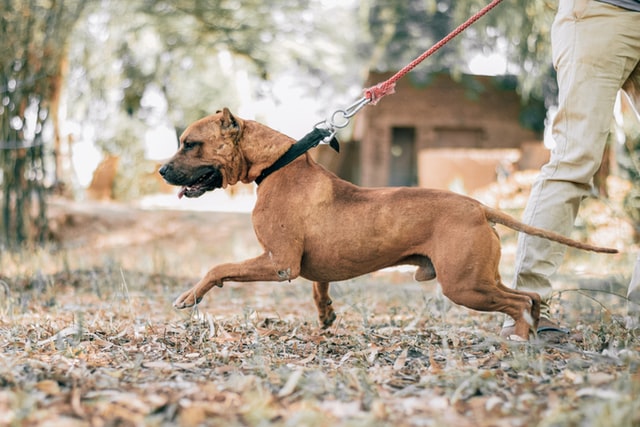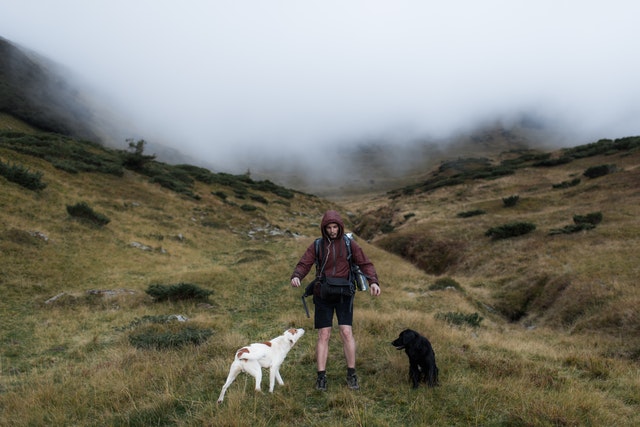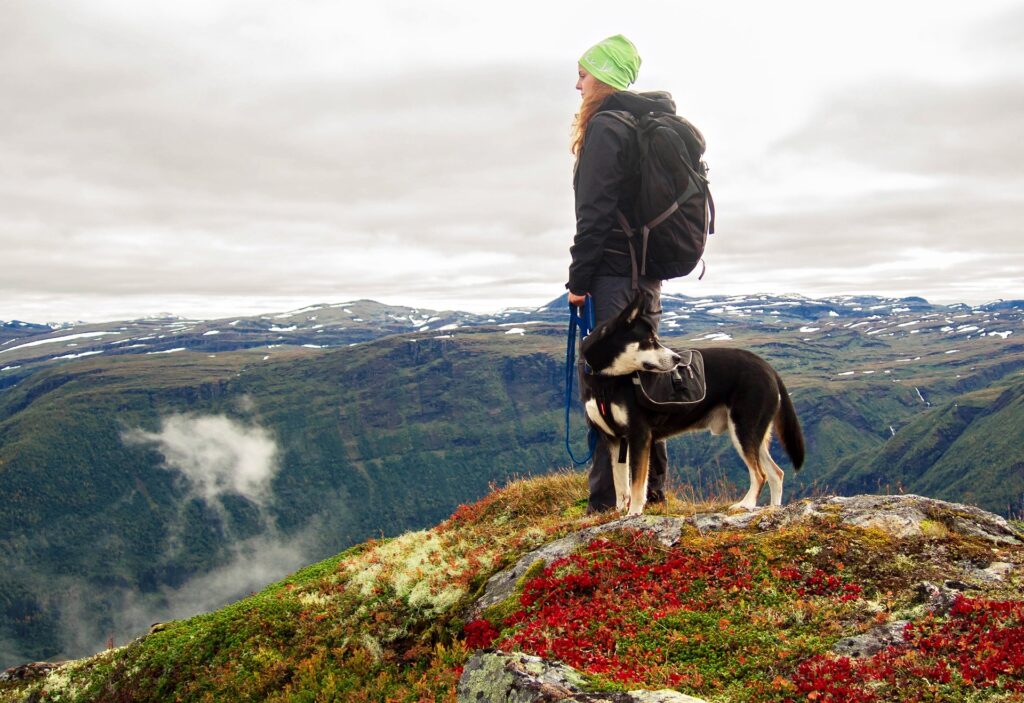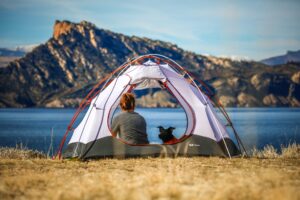Hiking with dogs can be a great experience, but it’s important to be prepared. In this blog post, we will discuss the tips for hiking with dogs, the gear you’ll need, and how to plan your hike. We’ll also provide some helpful resources so you can get out and enjoy the great outdoors with your furry friend!
1. Planning the hike?
The first thing to do when going on a hike is to plan the hike. Planning the hike is the important because you’ll need to make sure your furry friend will have a good time too. You’ll also want to make sure that you’re both safe and comfortable during the hike. Given below are some tips that will help you plan your hike:
a) Find Dog-Friendly Trails
One of the most important things to consider when hiking with your dog is finding a trail that is dog-friendly. While some trails allow dogs, others do not – and this is typically for the safety of both the dogs and the wildlife. When planning your hike, be sure to check the trail regulations to see if dogs are allowed. If not, there are plenty of other trails to choose from!
Here are a few resources to help you find dog-friendly trails:
- AllTrails: This website allows you to search for trails by location and includes filters for things like dog-friendliness, length, difficulty, etc. For example, using this website here are the dog-friendly Trails in Redding, California
- hikewithyourdog.com: This website is a great resource for finding dog-friendly trails as well as tips on hiking with your dog.
- Your local parks and recreation website: Many local parks and recreation websites have information on hiking trails in the area, including whether or not they allow dogs.
Also, you need to consider the below when deciding on a hiking trail.
Water bodies: If the trail you are hiking includes any water bodies, it’s important to take extra precautions with your dog. Some dogs are natural swimmers and love to play in the water, while others may be afraid of it. It’s best to find out before you hike if your dog will be comfortable around water.
If your dog is uncomfortable around water, there are a few things you can do to help them:
- Bring a life jacket for your dog: This will help your dog stay afloat if they happen to fall in.
- Put a bandana on your dog: This can help keep your dog calm and focused if they get scared by the water.
- Bring along some treats: Having some treats on hand can help lure your dog away from the water if they’re getting too close for comfort.
Cliffs: If the trail you are hiking has any cliffs, it is important to be extra careful with your dog. Some dogs may not be aware of the danger and could easily fall off, so it’s best to keep them on a leash at all times.
Hunting areas: If the trail you are hiking goes through a hunting area, it’s important to be aware of the dangers. Hunting season varies depending on the state, but it’s typically from October to December.
During hunting season, it’s best to avoid hiking trails that are known to be popular with hunters. If you must hike in a hunting area, be sure to wear bright colors and make noise so the hunters are aware of your presence.
You should also avoid hiking with your dog off-leash, as they could easily be mistaken for game.
Now that you’ve chosen a trail and are aware of the hazards, it’s time to start packing!
b) Remember Food, Water, and Treats
Like humans, dogs need food and water to fuel their hiking adventures.
When packing food and water for your dog, it’s important to consider their size and activity level.
A good rule of thumb is to pack 1 liter of water for every 2 hours of hiking, plus an extra cup for each stop.
As per the American Hiking Society, you need to carry at least 8 ounces of water per dog per hour of hiking. So if you expect the hike to last for 4 hours you need to carry 32 ounces of water.
As for food, you’ll want to pack more than you think your dog will need. Some of the perfect dog treats for hiking are Kibble, Energy Bars & Treats, Dog Biscuits, and Dog Food Rolls
c) Plan for the Weather when hiking with your dog

Another important consideration when hiking with your dog is the weather.
- Check the forecast before you go: If it’s hot, consider putting a cooling vest on them. If it’s cold, be sure to put a coat on your dog.
- Bring extra water: As mentioned before, it’s important to pack plenty of water for your dog. But in hot weather, you’ll want to bring even more.
- If you’re hiking in the summer, consider hiking in the early morning or evening to avoid the hottest part of the day.
- In the winter, be sure to pack extra food and water as well as a blanket for your dog.
d) Learn about the rules of each hiking place
Be sure to familiarize yourself with the rules of each hiking trail before you go.
- Some trails may require dogs to be on a leash at all times, while others may allow dogs to be off-leash.
- Some trails may also have certain areas that are off-limits to dogs.
Be sure to check the website or call the park in advance to find out their policies.
c) Protect against critters and other dangers
There are many dangers that dogs can encounter while hiking, from bugs to wildlife.
To protect your dog from these dangers,
- Use bug spray: Be sure to put bug spray on your dog as well as yourself.
- Watch for snakes: If you’re hiking in an area with snakes, be sure to keep an eye out for them.
- Watch out for wild animals: Keep your dog away from wild animals by keeping them on a leash. You never know when you might encounter a wild animal while hiking.
d) Train Your Dog Before You Hike
Before you hit the trails with your dog, it’s important to train them first.
- Start with short hikes: If your dog is new to hiking, start with short hikes close to home.
- Build up their endurance: Once your dog is comfortable hiking for short periods of time, you can start to increase the distance and duration of your hikes.
- Teach them hiking etiquette: Be sure to teach your dog hiking etiquette, such as not barking at other hikers or pulling on the leash.
- Obedience training: It’s also a good idea to enroll your dog in obedience training. This will teach them commands that can be helpful on the trail, such as “sit” or “stay.”
- Practice good manners and consistent recall: hiking with your dog is a great way to bond with them. But it’s important to be respectful of other hikers and wildlife. Be sure to practice good manners and have a consistent recall with your dog before you hit the trails.
e) Get Your Dog’s Paws Ready for Hiking
Your dog’s paws are their most important asset when hiking.
- Keep them clean and trimmed: Be sure to keep your dog’s paws clean and trimmed. This will help to prevent any cuts or scrapes.
- Use paw balm: Paw balm can help to protect your dog’s paws from hot pavement or rough terrain.
- Choose the right dog hiking boots: If you’re hiking in an area with lots of rocks or snow, you may want to consider getting your dog hiking boots.
- Bring a first-aid kit: It’s always a good idea to bring a first-aid kit when hiking with your dog. This way, you’ll be prepared if they injure their paw or get a cut.
Now that you’ve considered the trail and the other unexpected situations that may arise, it’s time to think about what gear you’ll need for your hike.
2. Gear Required When Hiking With Dogs

You and your furry friend can enjoy hiking together, but there’s some gear you’ll need to make sure both of you are safe and comfortable.
Given below is a list of essential gear to take on your hike:
- A Good dog hiking backpack
- A Dog hiking harness
- Dog hiking boots
- A hiking blanket
- Identification tag or microchip
- Collapsible bowls
- Poop bags or small spade
- Reflective jacket and small light
- Clothing and accessories
- Pet-safe insect repellent
- sunscreen
- First aid-kit For hiking with dogs
a) A Good Dog hiking Backpack
One of the most important pieces of gear you’ll need when hiking with your dog is a good dog hiking backpack.
- Look for a backpack that fits your dog well and has plenty of room for all of their gear.
- Be sure to pack their food, water, and a first-aid kit in the backpack.
- You may also want to pack some dog hiking boots and a blanket.
b) A Dog hiking Harness
Another important piece of gear you’ll need is a dog hiking harness.
- Look for a harness that fits your dog well and is comfortable for them to wear.
- Be sure to adjust the harness so that it’s tight enough that your dog can’t slip out of it, but not so tight that it’s uncomfortable.
- You may also want to consider a hiking leash.
c) Dog hiking Boots
If you’re hiking in an area with lots of rocks or snow, you may want to consider getting your dog hiking boots.
- Look for boots that fit your dog well and are comfortable for them to wear.
- Be sure to get the right size boots so that they don’t slip off.
- You may also want to get boot liners to help keep your dog’s feet warm and dry.
d) A hiking blanket
Another piece of gear you may want to consider is a hiking blanket.
- Look for a blanket that is big enough to cover your dog and will keep them warm in case of emergency.
- Be sure to pack the blanket in your backpack so that you always have it with you.
e) Identification Tag or Microchip
It’s important to make sure your dog is always wearing an identification tag or microchip when hiking.
- Most importantly, include your pet’s name and your contact information on the tag.
- You may also want to include your other details like address, the dog’s medical needs (if any) and microchip information information.
- If you’re using a microchip, be sure to register it. You can check the link here for steps to do it.
f) Collapsible Bowls
You’ll also need to bring along some collapsible bowls for your dog to drink out of and eat from.
g) Poop bags or Small Spade
You’ll also need to bring along some poop bags or a small spade.
- Be sure to pick up your dog’s waste and dispose of it properly.
- You may also want to bury your dog’s waste if you’re hiking in an area where that is required.
h) Reflective Jacket and Small Light
If you’re hiking at night or in an area with low visibility, you’ll need to bring along a reflective jacket and small light.
- Be sure to put the reflective jacket on your dog so that they can be seen.
- You may also want to attach the light to their collar or harness.
i) Clothing and Accessories
Depending on the weather and the terrain, you may also need to bring along some additional clothing and accessories for your dog.
- If it’s cold, you may want to bring a sweater or coat for your dog to wear.
- If it’s hot, you may want to bring a cooling vest or bandana.
j) Pet-safe insect repellent
If you’re hiking in an area with insects, you’ll need to bring along pet-safe insect repellent. Be sure to apply the repellent to your dog’s coat and avoid their eyes, nose, and mouth.
k) sunscreen
You may also want to apply sunscreen to your dog if you’re hiking in an area with extreme heat. Be sure to use a sunscreen that is safe for dogs.
l) First Aid Kit For hiking with dogs
Last but not least, you’ll need to pack a first-aid kit for your dog.
- Be sure to include items like gauze, bandages, antiseptic wipes, and tweezers.
- You may also want to include a book on first aid for dogs.
Tips For Hiking With Your Dog
Now that you’ve got the gear, it’s time to hit the trails! Here are some tips for hiking with your dog.
Keep your dog on a leash
Even the best-behaved dog can be unpredictable when hiking in new and unfamiliar territory. There are many hazards on the trail, including other hikers, cyclists, and wildlife. By keeping your dog on a leash, you can help to ensure their safety as well as the safety of others.
Be aware of wildlife
Depending on where you are hiking, there may be wildlife present. Bears, mountain lions, snakes, and other animals can pose a threat to both you and your dog. Be sure to research the area you’ll be hiking in and take precautions accordingly.
Watch out for poisonous plants
There are many plants that can be poisonous to dogs if they are ingested. Be on the lookout for poison ivy, oak, and sumac, as well as mushrooms. If you’re not sure if a plant is safe, it’s best to err on the side of caution and avoid it altogether.
Pack plenty of water and food
You’ll need to bring enough water and food for both yourself and your dog. As for food, bring along more than you think you’ll need in case your hike takes longer than expected.
Bring all the necessary hiking gear
In addition to water and food, you’ll also need to bring along some hiking gear for your dog. This includes a leash, collar or harness, poop bags, and a first-aid kit that includes supplies for both you and your dog.
Pick up your dog’s waste
No one likes hiking in a minefield of dog poop. Be sure to clean up after your dog and pack out their waste.
Choose a dog-friendly trail
Not all trails are created equal. Some trails are too steep, Rocky, or have other hazards that can be dangerous for dogs. Be sure to choose a hiking trail that is appropriate for your dog.
Avoid trails that are too long, difficult, or have a lot of traffic.
Hike when the weather is right
The weather can be just as hard on your dog as it is on you. Avoid hiking in extreme weather conditions.
Familiarize yourself with the trail
Before hiking with your dog, be sure to familiarize yourself with the trail. This includes knowing where the trailhead is, what the terrain is like, and what the weather conditions will be. You can do this by reading maps and guidebooks. By being prepared, you can help to ensure a safe and enjoyable hike for both you and your dog.
After hiking tip: Ticks can carry diseases that are harmful to both you and your dog. Be sure to check your dog for ticks after your hike and remove them immediately if you find any.
Dogs make great hiking companions. By following these tips and with a little preparation, you can help to ensure a safe and enjoyable hike for both you and your furry friend. Happy hiking!









